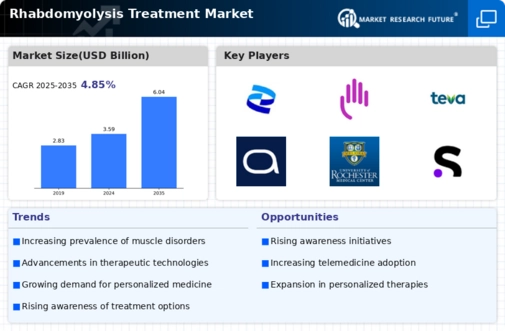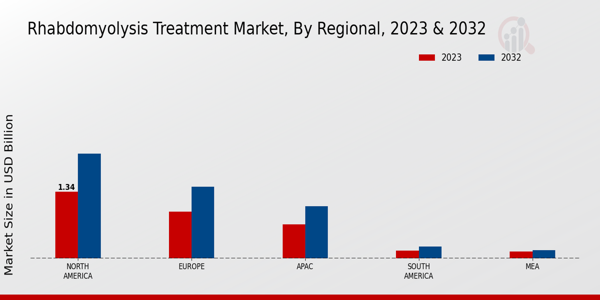Market Growth Projections
The Global Rhabdomyolysis Treatment Market Industry is projected to experience substantial growth over the next decade. With an estimated market value of 3.59 USD Billion in 2024, the industry is expected to expand to approximately 6.04 USD Billion by 2035. This growth trajectory indicates a robust compound annual growth rate (CAGR) of 4.84% from 2025 to 2035. The increasing prevalence of rhabdomyolysis, coupled with advancements in treatment modalities and heightened awareness, contributes to this optimistic outlook. Stakeholders in the healthcare sector are likely to capitalize on these trends, driving further innovation and investment in the market.
Growing Geriatric Population
The aging population worldwide is a significant driver for the Global Rhabdomyolysis Treatment Market Industry. Older adults are more susceptible to conditions that can lead to rhabdomyolysis, such as falls, dehydration, and the use of multiple medications. As the geriatric demographic expands, the incidence of rhabdomyolysis is likely to increase, necessitating effective treatment solutions. Healthcare systems are adapting to this demographic shift by developing targeted therapies and management protocols. This trend underscores the importance of addressing the unique needs of older patients, further propelling market growth in the coming years.
Increased Awareness and Education
Heightened awareness and education regarding rhabdomyolysis among healthcare professionals and the general public are pivotal for the Global Rhabdomyolysis Treatment Market Industry. Educational initiatives aimed at recognizing symptoms and understanding risk factors are crucial in promoting early diagnosis and treatment. This increased awareness leads to timely interventions, thereby reducing the severity of the condition. As healthcare systems prioritize education and training, the demand for effective treatment options is likely to rise. Consequently, this trend supports the market's growth trajectory, contributing to an expected CAGR of 4.84% from 2025 to 2035.
Rising Incidence of Rhabdomyolysis
The Global Rhabdomyolysis Treatment Market Industry is experiencing growth due to the increasing incidence of rhabdomyolysis, which is often linked to factors such as intense physical activity, trauma, and certain medications. Reports indicate that the prevalence of this condition is rising, particularly among athletes and individuals engaging in strenuous exercise. This trend is expected to drive demand for effective treatment options, as healthcare providers seek to address the growing number of cases. As the market evolves, it is projected to reach approximately 3.59 USD Billion by 2024, reflecting the urgent need for innovative therapies and management strategies.
Advancements in Treatment Modalities
Innovations in treatment modalities significantly influence the Global Rhabdomyolysis Treatment Market Industry. Recent developments in pharmacological interventions and supportive care strategies enhance patient outcomes and reduce complications associated with rhabdomyolysis. For instance, the introduction of novel intravenous fluids and renal protective agents has shown promise in clinical settings. These advancements not only improve recovery rates but also contribute to the overall market growth. As the industry adapts to these innovations, the market is anticipated to expand, potentially reaching 6.04 USD Billion by 2035, driven by the continuous evolution of treatment approaches.
Regulatory Support for Treatment Development
Regulatory bodies play a crucial role in shaping the Global Rhabdomyolysis Treatment Market Industry by facilitating the development and approval of new treatment options. Initiatives aimed at expediting the review process for innovative therapies can significantly impact market dynamics. For example, the introduction of fast-track designations for promising treatments encourages pharmaceutical companies to invest in research and development. This supportive regulatory environment fosters innovation and enhances the availability of effective treatments for rhabdomyolysis. As a result, the market is poised for growth, reflecting the ongoing commitment to improving patient care.













